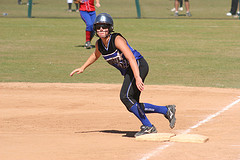After coaching softball on the high school level for seven years and on the summer travel level for five years, I am convinced that the quality of baserunning is extremely poor–that most coaches on the scholastic level are not playing enough attention to the basic fundamentals.
Is it because they are spending too much of their time on batting practice? Certainly, hitting is hugely important, but I sincerely believe that on the high school level, base running will win as many games as bats.

There are different aspects to running the bases, beginning with whether the defense can make the play at first base, the runner should run directly through the base, touching the front part of the base with the foot that gets there first. (Note: If the “safebase is used at first, runner must hit the orange portion of the bag)
She should then tuck her chin on the right shoulder and check for an overthrow. If there has been one, she must aggressively seek to advance.
The common mistake made by baserunners on a normal throw is to turn toward the foul lines as they return to first.
That is baseball mentality at work. In softball, you are allowed to turn to the left (toward the field) as long as you do not make an attempt to advance. The turn to the left will enable you to keep your eye on the ball.
An errant throw back to the pitcher will usually provide a shorter route to second.
If there is no play at first, the runner should banana out upon approaching the bag and make an aggressive turn toward second.
If the defense throws behind her, she should go right to second. In short, she should put pressure on the defense to make them throw.
A common saying I use is: “Run to first as if it’s a double!” This will increase your girls’ aggressiveness on the basepaths.
In our system of baserunning, the delayed steal has a higher success rate than the straight steal. It is predicated on our takeoff and lead as the ball is released by the pitcher.
The runner sets up in sprinter fashion in one of two ways. The first is a rocker step, with the left (front) foot on the corner of the base and the right foot alongside the right-field side of the base, but not quite touching it.
Note: We don’t want the right foot to be set behind the base where the runner might trip over it as the back foot comes forward.
The runner may also choose to set up in a right foot stance, with the right foot out front.
The take-off in both stances are made off the left foot, creating the explosion into the three-step lead-right step, left step, and then a third step on which the runner turns forward to face home with her body crouched over her spread feet.
Both take-offs are acceptable and efficient. The key lies in getting the proper initial three-step lead off first base.
Assuming the batter doesn’t swing and there is no wild pitch, we hold our three-step lead and dare the catcher to throw the ball to first.
If she does this, the runner will take off for second. She will be safe over 95% of the time. What usually happens is that the first baseman will look to tag the runner, who will be three-quarters of the way to second.
Another reason for that high percentage is that on a straight steal the catcher has to throw the ball 84’ 10” and the runner has to run 60 feet.
On the delayed steal, the base runner usually has to run approximately 48’ (with proper lead) and there has to be two throws–catcher-to-first-baseman and first-baseman-to-shortstop covering second.
These two throws are about 120’ in length and the first baseman has to hit a moving target with an obstruction (the base runner).
My summer team was 39 out of 40 times last summer doing this.
Off of second base, your lead is five steps (four and turn) and you can steal third on the throw back to the pitcher.
If you take off on the throw back, you will be safe. If you hesitate or don’t get the proper initial lead, you will not make it.
Also, if the catcher throws the ball directly to second, you’ll be able to “crawl” to third base.
The lead off of third base is a two-step walking lead in foul territory. It is a walking lead because we want our momentum going forward to enable us to score on wild pitches or past balls.
We can also score from third on the delayed steal. This is done when the catcher throws to third base to pick off the runner. We do not attempt this as much, but its success rate is very good.
With two outs, we increase our leads off each base by at least two steps. We are more aggressive in this situation because we no longer have to fear the line-out play.
We devote approximately 60-70% of our practice time to base running. The rest of practice is spent on defense and bunting.
We spend little time on batting practice, maybe once per week.
Our team finished 20-3 and were league champions last season, averaging 10.7 runs per game while only giving up 3.2, and we scored over 15 runs in a game five times.So, coaches, instead of devoting most of your time to hitting, brush up on your base running and run your way to victory!